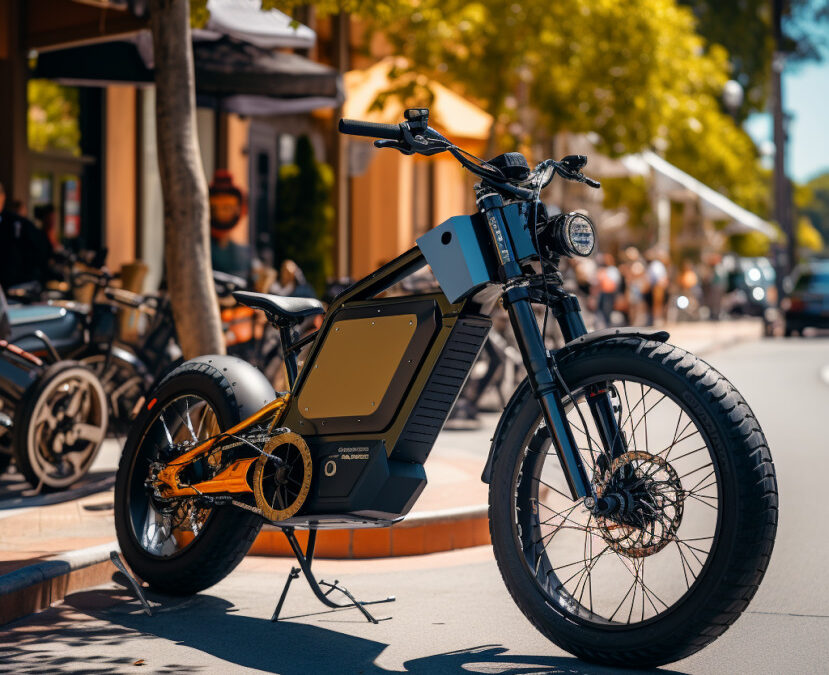Did you know that there is sometimes confusion surrounding whether or not electric bicycles, also known as ebikes, are considered motorized vehicles? With their rising popularity, it’s important to understand how they are classified and regulated. In this article, we will explore the definition of an ebike and discuss the legal implications of owning and riding one. So, if you’ve ever wondered where ebikes stand in terms of motorization, buckle up and let’s get started!
Definition of an Ebike
An ebike, short for electric bicycle, is a type of bicycle that is equipped with an electric motor and a battery. The electric motor provides assistance to the rider’s pedaling, making it easier to climb hills, maintain speed, and cover longer distances. Unlike traditional bicycles that rely solely on human power, ebikes provide a customizable level of electric assistance, allowing riders to choose how much they want to rely on the motor.
Classification of Ebikes
Ebikes are classified based on the level of assistance provided by the electric motor. The two main categories of ebikes are pedal-assist and throttle-controlled.
- Pedal-assist ebikes, also known as pedelecs, require the rider to pedal in order for the electric motor to provide assistance. The motor senses the rider’s pedaling motion and automatically adjusts the level of assistance based on the speed and force of the pedaling.
- Throttle-controlled ebikes, on the other hand, have a throttle similar to that of a motorcycle or scooter. The rider can simply twist the throttle to activate the electric motor and receive assistance without needing to pedal.
Components of an Ebike
An ebike consists of several key components that work together to provide electric assistance and ensure a smooth riding experience. These components include:
- The electric motor: The heart of the ebike, the electric motor is responsible for providing assistance to the rider. It is typically located either in the front or rear wheel hub or integrated into the crankshaft.
- The battery: The battery stores the electrical energy required to power the electric motor. It is usually removable and rechargeable, allowing riders to easily replenish the battery when needed.
- The controller: The controller serves as the brain of the ebike, regulating the flow of electricity between the battery and the motor. It also allows riders to adjust the level of electric assistance and monitor important data such as speed and battery level.
- The display: The display, often located on the handlebars, provides riders with information about the speed, distance traveled, battery level, and other important metrics. It may also include additional features such as a built-in GPS or a USB charging port.
- The sensors: Various sensors, such as cadence sensors and torque sensors, are used to detect the rider’s pedaling motion and adjust the level of assistance accordingly. These sensors ensure a seamless integration between the rider’s efforts and the electric motor’s assistance.
Power Limits for Ebikes
Different countries and regions have specific regulations regarding the power limits of ebikes. In most jurisdictions, ebikes are limited to a maximum power output of 250 watts. However, there are variations in terms of the speed at which the electric motor stops providing assistance. In some areas, the motor assistance cuts off at 25 kilometers per hour (about 15.5 miles per hour), while in others, it may be higher or lower.
These power limits are in place to ensure that ebikes are still primarily human-powered vehicles and not considered as fully motorized vehicles. By setting these limits, authorities aim to maintain a balance between providing assistance to the rider and promoting safety on the roads.
Legal Definition of a Motorized Vehicle
In order to better understand how ebikes are classified and regulated, it is important to have a clear understanding of the legal definition of a motorized vehicle. The definition may vary depending on the country or jurisdiction, but generally, a motorized vehicle is defined as any vehicle that is powered by an engine or motor, regardless of its size or purpose.
Laws and Regulations
Laws and regulations regarding motorized vehicles vary from country to country and even within different states or provinces. These laws aim to establish guidelines for the safe use of motorized vehicles on public roads, including requirements for licensing, registration, and compliance with traffic laws.
Classification of Motorized Vehicles
Motorized vehicles are typically classified into different categories based on their design, purpose, and power source. Common classifications include motorcycles, mopeds, scooters, and automobiles. Each category may have specific requirements and restrictions based on factors such as engine displacement, top speed, and age restrictions.
Licensing and Registration
Motorized vehicles generally require some form of licensing and registration to legally operate on public roads. This process usually involves obtaining a driver’s license or a separate motorcycle license, as well as registering the vehicle with the appropriate authorities. These requirements are put in place to ensure that operators have the necessary skills and knowledge to safely operate motorized vehicles and that the vehicles meet certain safety standards.
Ebikes and Motorized Vehicle Classification
Ebikes, with their electric motors, exist in a unique space between traditional bicycles and fully motorized vehicles. Understanding how ebikes are classified in relation to motorized vehicles can help determine the appropriate regulations and restrictions.
Distinguishing Characteristics
The main distinguishing characteristic of ebikes is that they are primarily intended to be powered by human pedaling, with the electric motor providing assistance rather than full propulsion. This sets ebikes apart from fully motorized vehicles that rely solely on the motor for propulsion.
Difference in Power Source
Traditional motorized vehicles, such as motorcycles and automobiles, are powered by internal combustion engines that burn fuel to generate mechanical power. In contrast, ebikes use electric motors powered by rechargeable batteries. This fundamental difference in power source highlights the unique nature of ebikes as a hybrid between bicycles and motorized vehicles.
Ebikes and Internal Combustion Engines
One key distinction between ebikes and traditional motorized vehicles is the absence of an internal combustion engine in ebikes. Internal combustion engines generate emissions, such as carbon dioxide and pollutants, which contribute to air pollution and climate change. Ebikes, being powered by electric motors, produce zero tailpipe emissions, making them a more environmentally friendly mode of transportation.
Ebikes vs. Electric Motorcycles
While ebikes and electric motorcycles both utilize electric motors, there are significant differences in terms of speed, power, and legal classification.
Speed and Power Comparison
Ebikes are generally designed for lower speeds and lower power outputs compared to electric motorcycles. Ebikes are typically limited to a maximum speed of 25 kilometers per hour (about 15.5 miles per hour) and have power outputs of 250 watts or less. In contrast, electric motorcycles can reach higher speeds and have more powerful motors, often exceeding 50 kilometers per hour (about 31 miles per hour) and several thousand watts.
Licenses and Regulations
The legal requirements for operating an electric bicycle are generally less stringent compared to those for electric motorcycles. In many jurisdictions, riding an ebike does not require a specific license or registration, as long as the power and speed limits are complied with. Electric motorcycles, on the other hand, usually require a motorcycle license and registration, similar to their gasoline-powered counterparts.
Operation on Public Roads
Ebikes are typically allowed to be ridden on public roads and bike lanes, similarly to traditional bicycles. They are subject to the same traffic laws and regulations as bicycles, such as obeying traffic signals and yielding to pedestrians. Electric motorcycles, on the other hand, may have specific restrictions on where they can be operated, such as being limited to roads designated for motorized vehicles.
Legal Status of Ebikes
The legal status of ebikes varies from country to country and even within different states or provinces. The classification and regulations surrounding ebikes are influenced by factors such as the power output, maximum speed, and whether they are considered bicycles or motorized vehicles.
International Variances
Different countries have different regulations and classifications for ebikes. For example, some countries may have a maximum power output of 250 watts, while others may allow higher power outputs. The maximum speed at which the electric motor provides assistance can also vary. Additionally, some countries may have age restrictions or require specific driver’s licenses for certain types of ebikes.
Country-Specific Laws
In many countries, ebikes are classified as bicycles and therefore subject to the same regulations and requirements. However, some countries have specific regulations for ebikes, such as speed limits, power output limitations, and age restrictions. It is important for riders to familiarize themselves with the specific laws and regulations in their country to ensure they are legally compliant.
State and Local Regulations
Aside from national laws, ebike regulations can also vary at the state or local level. Some states or provinces within a country may have additional restrictions or requirements for ebikes, such as speed limits or specific equipment that must be installed on the ebike. It is important to check with the local transportation authorities to ensure compliance with all relevant regulations.
Types of Ebike Regulations
When it comes to regulating ebikes, there are various aspects that authorities take into consideration. These regulations aim to strike a balance between promoting the use of ebikes while ensuring safety on the roads.
Power Output Limitations
Many regulations place limits on the power output of ebikes to ensure that they are still primarily human-powered vehicles. Typically, this limit is set at 250 watts or lower. By imposing these limitations, authorities encourage riders to actively participate in the cycling experience while still providing assistance when needed.
Pedal-Assist vs. Throttle-Controlled
Regulations also often differentiate between pedal-assist and throttle-controlled ebikes. Pedal-assist ebikes require the rider to pedal in order for the motor to provide assistance, while throttle-controlled ebikes can be operated solely by using the throttle without any pedaling. Some jurisdictions may have separate regulations or requirements for these two types of ebikes, such as speed limits or age restrictions.
Age Restrictions
To ensure the safe operation of ebikes, age restrictions are sometimes imposed. These restrictions vary depending on the country or jurisdiction and may be based on factors such as the power output of the ebike or the type of road on which it is being ridden. Age restrictions aim to ensure that riders have the necessary physical and cognitive abilities to safely operate an ebike.
Ebikes on Public Roads
With the increasing popularity of ebikes, it is important to understand the laws and regulations that pertain to their use on public roads. Just like any other vehicle, ebike riders must comply with traffic laws and prioritize safety.
Traffic Laws and Regulations
Ebikes are subject to the same traffic laws and regulations as bicycles in most jurisdictions. This means riders must adhere to speed limits, stop at traffic lights and stop signs, yield to pedestrians, and use appropriate hand signals when turning. It is crucial for ebike riders to familiarize themselves with the traffic laws specific to their location to ensure safe and responsible riding.
Safety Gear Requirements
While specific safety gear requirements for ebike riders may vary depending on the jurisdiction, it is generally recommended to wear a helmet. Wearing protective gear, such as knee and elbow pads, is also a good practice, especially for riders who plan to ride at higher speeds or on more challenging terrains.
Sharing the Road with Vehicles
Ebikes are typically allowed to share the road with other vehicles, including cars, motorcycles, and bicycles. However, it is important for ebike riders to be aware of their surroundings, signal their intentions clearly, and ride defensively. Sharing the road with larger and faster vehicles requires caution, and riders should make themselves visible and communicate their movements effectively to ensure their safety.

Benefits and Limitations of Ebikes
Ebikes offer numerous benefits, both for individuals and the environment. However, it is important to consider their limitations as well.
Environmental Impact
One of the most significant advantages of ebikes is their positive impact on the environment. By using electric motors powered by rechargeable batteries, ebikes produce zero tailpipe emissions. This helps reduce air pollution and greenhouse gas emissions, making them an environmentally friendly alternative to traditional motorized vehicles.
Health and Fitness Benefits
Ebikes provide an excellent opportunity for individuals to improve their health and fitness levels. While the electric motor provides assistance, riders still need to actively pedal, which promotes physical activity and can contribute to weight loss and cardiovascular health. Ebikes also make it easier for individuals who may not be able to ride traditional bicycles due to physical limitations or fitness levels to participate in cycling.
Range and Battery Limitations
One of the limitations of ebikes is the range they can cover on a single battery charge. Battery technology is constantly improving, but currently, most ebikes have a range of around 40 to 80 kilometers (about 25 to 50 miles) per charge, depending on factors such as terrain, weight of the rider, and level of electric assistance. This range may be limiting for individuals who need to cover longer distances regularly.
Future of Ebike Regulations
As ebikes continue to grow in popularity, regulations surrounding their use are likely to evolve and adapt to the changing landscape of transportation. Several key factors will influence the future of ebike regulations.
Evolution of Laws
As technology advances and the capabilities of ebikes improve, it is likely that regulations will be revised to accommodate these advancements. This may include changes in power limits, speed restrictions, and safety requirements. Authorities will need to strike a balance between encouraging innovation and ensuring safety on the roads.
Infrastructure Development
The integration of ebikes into existing transportation infrastructure will also play a role in future regulations. As ebike usage becomes more widespread, cities and urban areas may need to invest in infrastructure improvements, such as dedicated bike lanes and charging stations. This will not only encourage the use of ebikes but also contribute to overall safety and convenience.
Industry Growth and Innovation
The growth of the ebike industry and continued innovation in technology will inevitably influence regulations. As more companies and manufacturers enter the market, new types of ebikes may emerge, requiring regulators to adapt and establish appropriate classifications and standards. This ongoing dialogue between the industry and regulatory bodies will shape the future of ebike regulations.

Conclusion
Ebikes, with their unique combination of human power and electric assistance, are redefining the way people commute and explore their surroundings. Understanding the legal classification and regulations surrounding ebikes is crucial for riders to ensure their safety and compliance with local laws. As the popularity of ebikes continues to rise, it is important for authorities and policymakers to carefully consider the evolving landscape of transportation and establish appropriate regulations that balance innovation, safety, and environmental considerations. With the right regulations in place, ebikes have the potential to revolutionize urban mobility and contribute to a greener and healthier future.


